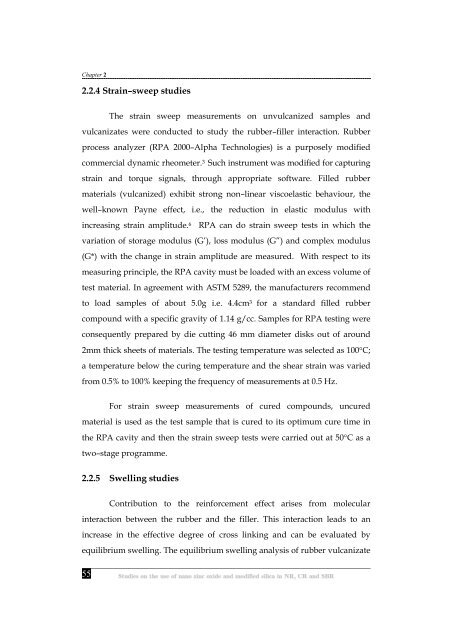Studies on the use of nano zinc oxide and modified silica in NR, CR ...
Studies on the use of nano zinc oxide and modified silica in NR, CR ...
Studies on the use of nano zinc oxide and modified silica in NR, CR ...
You also want an ePaper? Increase the reach of your titles
YUMPU automatically turns print PDFs into web optimized ePapers that Google loves.
Chapter 2<br />
2.2.4 Stra<strong>in</strong>–sweep studies<br />
55<br />
The stra<strong>in</strong> sweep measurements <strong>on</strong> unvulcanized samples <strong>and</strong><br />
vulcanizates were c<strong>on</strong>ducted to study <strong>the</strong> rubber–filler <strong>in</strong>teracti<strong>on</strong>. Rubber<br />
process analyzer (RPA 2000–Alpha Technologies) is a purposely <strong>modified</strong><br />
commercial dynamic rheometer. 3 Such <strong>in</strong>strument was <strong>modified</strong> for captur<strong>in</strong>g<br />
stra<strong>in</strong> <strong>and</strong> torque signals, through appropriate s<strong>of</strong>tware. Filled rubber<br />
materials (vulcanized) exhibit str<strong>on</strong>g n<strong>on</strong>–l<strong>in</strong>ear viscoelastic behaviour, <strong>the</strong><br />
well–known Payne effect, i.e., <strong>the</strong> reducti<strong>on</strong> <strong>in</strong> elastic modulus with<br />
<strong>in</strong>creas<strong>in</strong>g stra<strong>in</strong> amplitude. 6 RPA can do stra<strong>in</strong> sweep tests <strong>in</strong> which <strong>the</strong><br />
variati<strong>on</strong> <strong>of</strong> storage modulus (G’), loss modulus (G”) <strong>and</strong> complex modulus<br />
(G*) with <strong>the</strong> change <strong>in</strong> stra<strong>in</strong> amplitude are measured. With respect to its<br />
measur<strong>in</strong>g pr<strong>in</strong>ciple, <strong>the</strong> RPA cavity must be loaded with an excess volume <strong>of</strong><br />
test material. In agreement with ASTM 5289, <strong>the</strong> manufacturers recommend<br />
to load samples <strong>of</strong> about 5.0g i.e. 4.4cm 3 for a st<strong>and</strong>ard filled rubber<br />
compound with a specific gravity <strong>of</strong> 1.14 g/cc. Samples for RPA test<strong>in</strong>g were<br />
c<strong>on</strong>sequently prepared by die cutt<strong>in</strong>g 46 mm diameter disks out <strong>of</strong> around<br />
2mm thick sheets <strong>of</strong> materials. The test<strong>in</strong>g temperature was selected as 100°C;<br />
a temperature below <strong>the</strong> cur<strong>in</strong>g temperature <strong>and</strong> <strong>the</strong> shear stra<strong>in</strong> was varied<br />
from 0.5% to 100% keep<strong>in</strong>g <strong>the</strong> frequency <strong>of</strong> measurements at 0.5 Hz.<br />
For stra<strong>in</strong> sweep measurements <strong>of</strong> cured compounds, uncured<br />
material is <strong>use</strong>d as <strong>the</strong> test sample that is cured to its optimum cure time <strong>in</strong><br />
<strong>the</strong> RPA cavity <strong>and</strong> <strong>the</strong>n <strong>the</strong> stra<strong>in</strong> sweep tests were carried out at 50°C as a<br />
two–stage programme.<br />
2.2.5 Swell<strong>in</strong>g studies<br />
C<strong>on</strong>tributi<strong>on</strong> to <strong>the</strong> re<strong>in</strong>forcement effect arises from molecular<br />
<strong>in</strong>teracti<strong>on</strong> between <strong>the</strong> rubber <strong>and</strong> <strong>the</strong> filler. This <strong>in</strong>teracti<strong>on</strong> leads to an<br />
<strong>in</strong>crease <strong>in</strong> <strong>the</strong> effective degree <strong>of</strong> cross l<strong>in</strong>k<strong>in</strong>g <strong>and</strong> can be evaluated by<br />
equilibrium swell<strong>in</strong>g. The equilibrium swell<strong>in</strong>g analysis <strong>of</strong> rubber vulcanizate

















